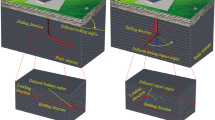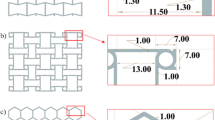Abstract
It is a common phenomenon that feed pellet is broken by compression and impact during the processing of manufacturing and production. At present, the breakage characteristics of feed pellet under repeated loading are not clear. In order to predict the breakage probability of feed pellet accurately, the compound feed for piglets feeding was selected to conduct repeated compression and repeated impacts tests in this paper. Firstly, the quasi-static repeated compression tests were conducted, and it was found that the cyclic stiffening occurred due to the densification of feed pellet during the repeated compression. Secondly, the quasi-static repeated compression tests in radial and axial direction were performed under different loading forces. And the results showed that the compressive energy required for feed pellet breakage increased with the decrease of loading force. Then, two-parameter Weibull function was used to fit the relationship between mass-specific compressive energy and breakage probability. And the fitting results R2 were all greater than 0.9 and the fitting effect was good. Finally, dynamic repeated impacts tests with different impact velocities were conducted. The results showed that the impact times required for feed pellet to reach the same breakage probability decreased, with the increase of impact velocity. Three-parameter Weibull function was used to fit the relationship between mass-specific impact energy and breakage probability. Good fitting effect was obtained and R2 was greater than 0.95. The fitting results can predict the breakage probability of feed pellet in the process of repeated loading, and provide guidance for the feed pellet production and transportation.
Graphical abstract
The breakage characteristics of feed pellet under reteated loading



















Similar content being viewed by others
References
Thomas, M., van der Poel, A.F.B.: Physical quality of pelleted animal feed. 1. Criteria for pellet quality. Anim Feed Sci Tech 61(1–4), 89–112 (1996). https://doi.org/10.1016/0377-8401(96)00949-2
Halstensen, M., Ihunegbo, F.N., Ratnayake, C., Sveinsvold, K.: Online acoustic chemometric monitoring of fish feed pellet velocity in a pneumatic conveying system. Powder Technol 263, 104–111 (2014). https://doi.org/10.1016/j.powtec.2014.05.007
Yang, G.Q., Sun, J.Y., Guo, D.X., Tian, H., Li, J.T.: Effects of dietary fiber source and crude fiber level on pellet quality, growth performance and meat quality of meat rabbits. Chin J Anim Nutr 27(10), 3084–3093 (2015). https://doi.org/10.3969/j.issn.1006-267x.2015.10.013
Ardiaca Garcia, M., Montesinos Barcelo, A., Bonvehi Nadeu, C., Jekl, V.: Respiratory diseases in guinea pigs, chinchillas and degus. Vet Clin N Am Exot Anim Pract 24(2), 419–457 (2021). https://doi.org/10.1016/j.cvex.2021.02.001
Chang, C.M., Fang, W., Jao, R.C., Shyu, C.Z., Liao, I.C.: Development of an intelligent feeding controller for indoor intensive culturing of eel. Aquacult Eng 32(2), 343–353 (2005). https://doi.org/10.1016/j.aquaeng.2004.07.004
Sun, H.Q., Zeng, Y.W., Ye, Y., Chen, X., Zeng, T.C.: Abnormal size effect of particle breakage probability under repeated impacts. Powder Technol 363, 629–641 (2020). https://doi.org/10.1016/j.powtec.2020.01.026
Han, Y.L., Zhao, D., Chu, Y.H., Zhen, J.X., Li, G.R., Zhao, H.W., Jia, F.G.: Breakage behaviour of single rice particles under compression and impact. Adv Powder Technol 32(12), 4635–4650 (2021). https://doi.org/10.1016/j.apt.2021.10.017
Rumpf, H.: Die einzelkornzerkleinerung als grundlage einer technischen zerkleinerungswissenschaft. Chem Ing Tech 37(3), 187–202 (1965). https://doi.org/10.1002/cite.330370303
Couroyer, C., Ning, Z.M., Ghadiri, M., Brunard, N., Kolenda, F., Bortzmeyer, D., Laval, P.: Breakage of macroporous alumina beads under compressive loading: simulation and experimental validation. Powder Technol 105(1–3), 57–65 (1999). https://doi.org/10.1016/s0032-5910(99)00118-7
Salman, A.D., Biggs, C.A., Fu, J., Angyal, I., Szabo, M., Hounslow, M.J.: An experimental investigation of particle fragmentation using single particle impact studies. Powder Technol 128(1), 36–46 (2002). https://doi.org/10.1016/s0032-5910(02)00151-1
Luding, S., Tomas, J.: Particles, contacts, bulk-behavior. Granul Matter 16(3), 279–280 (2014). https://doi.org/10.1007/s10035-014-0510-8
Aarseth, K.A., Prestlokken, E.: Mechanical properties of feed pellets: Weibull analysis. Biosyst Eng 84(3), 349–361 (2003). https://doi.org/10.1016/s1537-5110(02)00264-7
Aarseth, K.A.: Attrition of feed pellets during pneumatic conveying: the influence of velocity and bend radius. Biosyst Eng 89(2), 197–213 (2004). https://doi.org/10.1016/j.biosystemseng.2004.06.008
Aarseth, K.A., Perez, V., Boe, J.K., Jeksrud, W.K.: Reliable pneumatic conveying of fish feed. Aquacult Eng 35(1), 14–25 (2006). https://doi.org/10.1016/j.aquaeng.2005.06.006
Aas, T.S., Oehme, M., Sorensen, M., He, G., Lygren, I., Asgard, T.: Analysis of pellet degradation of extruded high energy fish feeds with different physical qualities in a pneumatic feeding system. Aquacult Eng 44(1), 25–34 (2011). https://doi.org/10.1016/j.aquaeng.2010.11.002
Kong, X.R., Liu, J., Yang, T.Y., Su, Y.C., Geng, J., Niu, Z.Y.: Numerical simulation of feed pellet breakage in pneumatic conveying. Biosyst Eng 218, 31–42 (2022). https://doi.org/10.1016/j.biosystemseng.2022.03.012
Kalman, H.: Attrition of powders and granules at various bends during pneumatic conveying. Powder Technol 112, 244–250 (2000). https://doi.org/10.1016/s0032-5910(00)00298-9
Tavares, L.M., Cavalcanti, P.P., de Carvalho, R.M., da Silveira, M.W., Bianchi, M., Otaviano, M.: Fracture probability and fragment size distribution of fired Iron ore pellets by impact. Powder Technol 336, 546–554 (2018). https://doi.org/10.1016/j.powtec.2018.06.036
Pauw, O.G., Mare, M.S.: The determination of optimum impact-breakage routes for an ore. Powder Technol 54, 3–13 (1988). https://doi.org/10.1016/0032-5910(88)80043-3
Goder, D., Kalman, H., Ullmann, A.: Fatigue characteristics of granular materials. Powder Technol 122, 19–25 (2002). https://doi.org/10.1016/s0032-5910(01)00390-4
Vervoorn, P.M.M., Austin, L.G.: The analysis of repeated breakage events as an equivalent rate process. Powder Technol 63(2), 141–147 (1990). https://doi.org/10.1016/0032-5910(90)80036-x
Tavares, L.M., King, R.P.: Modeling of particle fracture by repeated impacts using continuum damage mechanics. Powder Technol 123(2–3), 138–146 (2002). https://doi.org/10.1016/s0032-5910(01)00438-7
Han, T., Petukhov, Y., Levy, A., Kalman, H.: Theoretical and experimental study of multi-impact breakage of particles. Adv Powder Technol 17(2), 135–157 (2006). https://doi.org/10.1163/156855206775992328
Rozenblat, Y., Levy, A., Kalman, H., Peyron, I., Ricard, F.: A model for particle fatigue due to impact loads. Powder Technol 239, 199–207 (2013). https://doi.org/10.1016/j.powtec.2013.01.059
Beekman, W.J., Meesters, G.M.H., Becker, T., Gaertner, A., Gebert, M., Scarlett, B.: Failure mechanism determination for industrial granules using a repeated compression test. Powder Technol. 130(1–3), 367–376 (2003). https://doi.org/10.1016/s0032-5910(02)00238-3
Russell, A., Mueller, P., Tomas, J.: Multiple Compression of moist spherical elastic–plastic zeolite 4A granules. Chem Eng Technol 36(7), 1240–1248 (2013). https://doi.org/10.1002/ceat.201300109
Salman, Russell, A., Aman, S., Tomas, J.: Breakage probability of granules during repeated loading. Powder Technol 269, 541–547 (2015). https://doi.org/10.1016/j.powtec.2014.09.044
Mader-Arndt, K., Aman, S., Fuchs, R., Tomas, J.: Contact properties determination of macroscopic fine disperse glass particles via compression tests under cyclic loading/unloading. Adv Powder Technol 28(3), 687–696 (2017). https://doi.org/10.1016/j.apt.2016.10.028
Chen, Z.P., Wassgren, C., Ambrose, R.P.K.: Measured damage resistance of corn and wheat kernels to compression, friction, and repeated impacts. Powder Technol 380, 638–648 (2021). https://doi.org/10.1016/j.powtec.2020.11.012
Wang, C.Y., Ding, X.M., Yin, Z.Y., Peng, Y., Chen, Z.X.: Mechanical characteristics and particle breakage of coral sand under one-dimensional repeated loading. Acta Geotech 17(7), 3117–3130 (2022). https://doi.org/10.1007/s11440-021-01381-9
Zeng, Y., Mao, B.Q., Jia, F.G., Han, Y.L., Li, G.R.: Modelling of grain breakage of in a vertical rice mill based on DEM simulation combining particle replacement model. Biosyst Eng. 215, 32–48 (2022). https://doi.org/10.1016/j.biosystemseng.2021.12.022
Li, Y.M., Chandio, F.A., Ma, Z., Lakhiar, I.A., Sahito, A.R., Ahmad, F., Mari, I.A., Farooq, U., Suleman, M.: Mechanical strength of wheat grain varieties influenced by moisture content and loading rate. Int J Agric. Biol. Eng. 11, 52–57 (2018). https://doi.org/10.25165/j.ijabe.20181104.3737
Russell, A., Mueller, P., Tomas, J.: Quasi-static diametrical compression of characteristic elastic–plastic granules: energetic aspects at contact. Chem Eng Sci 114, 70–84 (2014). https://doi.org/10.1016/j.ces.2014.04.016
Stronge, W.J.: Unraveling paradoxical theories for rigid body collisions. J Appl Mech Trans ASME 58(4), 1049–1055 (1991). https://doi.org/10.1115/1.2897681
Stronge, W.J.: Impact mechanics. Cambridge University Press, Cambridge (2000). https://doi.org/10.1017/CBO9780511626432
Li, H.C., Zeng, R., Yang, T.Y., Niu, Z.Y.: Experimental study on the impact breakage characteristics of maize kernels. Trans Chin Soc Agric Eng 38(7), 29–37 (2022). https://doi.org/10.11975/j.issn.1002-6819.2022.07.004
Rozenblat, Y., Levy, A., Kalman, H., Tomas, J.: Impact velocity and compression force relationship equivalence function. Powder Technol 235, 756–763 (2013). https://doi.org/10.1016/j.powtec.2012.11.011
Rozenblat, Y., Grant, E., Levy, A., Kalman, H., Tomas, J.: Selection and breakage functions of particles under impact loads. Chem Eng Sci 71, 56–66 (2012). https://doi.org/10.1016/j.ces.2011.12.012
Weibull, W.: A statistical distribution function of wide applicability. J Appl Mech Trans ASME 18, 293–297 (1951). https://doi.org/10.1115/1.4010337
Vogel, L., Peukert, W.: Breadage behaviour of different materials—construction of mastercurve for the breakage probability. Powder Technol 129(1–3), 101–110 (2003). https://doi.org/10.1016/s0032-5910(02)00217-6
Petukhov, Y., Kalman, H.: Empirical breakage ratio of particles due to impact. Powder Technol 143, 160–169 (2004). https://doi.org/10.1016/j.powtec.2004.04.009
Funding
This work was financially supported by the National key research and development programme (2021YFD130003105).
Author information
Authors and Affiliations
Corresponding authors
Ethics declarations
Conflict of interest
The authors declare that they have no known competing financial interests or personal relationships that could have appeared to influence the work reported in this paper.
Additional information
Publisher's Note
Springer Nature remains neutral with regard to jurisdictional claims in published maps and institutional affiliations.
Rights and permissions
Springer Nature or its licensor (e.g. a society or other partner) holds exclusive rights to this article under a publishing agreement with the author(s) or other rightsholder(s); author self-archiving of the accepted manuscript version of this article is solely governed by the terms of such publishing agreement and applicable law.
About this article
Cite this article
Kong, X., Cao, Q., Zhao, Z. et al. Breakage probability of feed pellet under repeated compression and impacts. Granular Matter 25, 47 (2023). https://doi.org/10.1007/s10035-023-01343-w
Received:
Accepted:
Published:
DOI: https://doi.org/10.1007/s10035-023-01343-w




